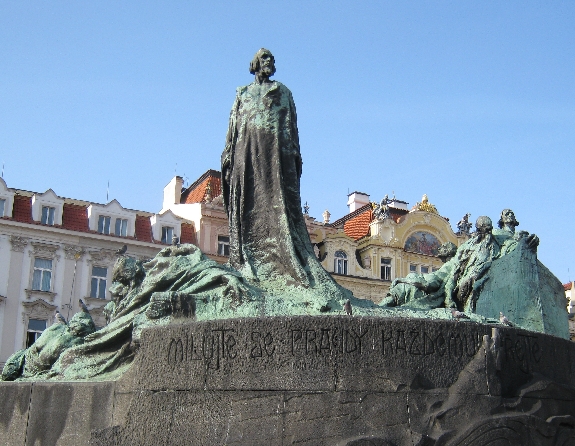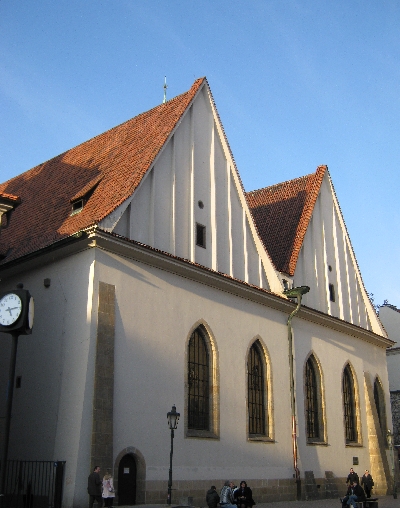The photograph above is of the imposing statue of Jan Hus, located in Staromestské námestí/Old Town Square, in the centre of Prague. It is the work of the Czech sculptor Ladislav Jan Šaloun and was unveiled in 1915 to mark the five-hundredth anniversary of the death of Hus who was burnt at the stake on 6th July 1415.
Jan Hus was born around 1369 in the village of Husinec in South Bohemia. At a young age he moved to Prague, becoming a student at Charles University. He gained his Bachelor of Arts degree in 1393, his Master degree in 1396 and was ordained as a Roman Catholic priest in 1400.
The building in Prague most associated with Hus is the Bethlehem Chapel. The original Chapel, completed in 1394, was built for the express purpose of the service of preaching rather than for the celebration of mass. In 1402, Hus was appointed Rector of the Bethlehem Chapel and took up residence in rooms immediately adjoining the Chapel
Over the following ten years, the preaching of Jan Hus drew large crowds to the Bethlehem Chapel. He was very much influenced by the teaching and writings of the early English Church Reformer John Wycliffe, and in his preaching, called for reform within the Roman Catholic Church. He was particularly outraged by the selling of papal indulgences to collect funds for military purposes.
However, there are two significant things which Hus did or advocated which are reflected in the way he is now remembered by most Czech people. Firstly, he preached and wrote in Czech rather than Latin as he wanted his hearers and readers to fully understand what he was saying. Secondly, he wanted worshippers to be able to receive communion in both kinds – both bread and wine – and for lay people not to be forbidden to receive the chalice.
After a papal edict of September 1412, prevented Hus from preaching in Prague, he withdrew to the South Bohemian countryside where he continued to preach under the open skies and where he also completed most of his writings. In October 1414, having been assured of safe passage, he travelled to Konstanz to attend a Church Council which had been called to resolve a variety divisive issues within the Church at that time including the existence of three different individuals each claiming to be Pope! However, as part of the proceedings of the Council of Konstanz, Jan Hus was tried, found guilty of heresy and condemned to death. He was burnt at the stake in Konstanz on 6th July 1415.
The supporters of Hus were outraged and the Hussite movement flourished following his death, bringing about the Bohemian Reformation. Sadly, there were divisions between those who desired moderate reform and those who wanted far more radical change within the Church. Eventually in 1620, at the Battle of White Mountain/Bilá hora on the outskirts of Prague, the army of the Holy Roman Emperor Ferdinand II defeated the forces of the Bohemian Estates and as a result, unreformed Roman Catholicism was reimposed upon Czech lands.
The Czech National Revival, which began in the late eighteenth century, regarded Hus as a Czech hero, not primarily for religious reasons but rather for political and cultural ones. His opposition to church control by the Vatican gave strength to those who opposed control of Czech lands by the Hapsburgs in the form of the Austro-Hungarian Empire. He preached and wrote in the Czech language and therefore was a focus for opposition to the Germanisation of government, education and culture in Bohemia and Moravia. Therefore the statue of Hus located in Staromestské námestí/Old Town Square, in the centre of Prague, is surrounded by figures of victorious Hussite warriors and the figure of a young mother symbolizing national rebirth.
The Bethlehem Chapel fell into a dilapidated state and was partially demolished in 1786. Three original walls remained standing within which a sizable apartment building was constructed in the 1830s. Following the establishment of an independent Czechoslovakia in 1918, there were moves by the new government to purchase the apartment complex and restore the Chapel. But nothing concrete ever materialised before the outbreak of World War Two.
At the end of the war in 1945, the apartment building was confiscated from its German owners and, between 1950 – 1954, the Bethlehem Chapel was restored with considerable care to its original form. Ironically this took place under the guidance of a Communist run Ministry of Culture. But even the Communists used the legacy of Jan Hus for their own purposes by portraying him as a proto-communist!
Inside the chapel, the earlier inscriptions on the walls have been restored on the basis of known texts with associated illustrations, as in this photograph. However, this second wall painting was not in the original chapel as it shows Hus being burnt at the stake!

Painting on the inside wall of the Bethlehem Chapel showing Jan Hus being burnt at the stake © Ricky Yates
All Czech Protestants also remember and celebrate Jan Hus and the symbol they use to do this is the chalice. This is because of Hus insisting that all Christian believers should receive communion in both kinds.
The picture on the left is of an Evangelical Church of Czech Brethren Church building in the Prague suburb of Žižkov. It too is called the Bethlehem Chapel/Betlémská kaple and was constructed in the cubist architectural style. On the left of the front façade is a bust of Jan Hus whilst on the right is a bust of John Calvin. But as can be seen in close-up detail below, above the front façade are a Bible and, on top of the Bible, a large gold chalice.
The photograph above is of a plaque on the outside of St. Clement’s Church which also belongs to the Evangelical Church of Czech Brethren. Like to statue in Old Town Square, this plaque was also erected on the 500th anniversary of the death of Jan Hus. With his picture, together with a chalice, thanks are given for ‘Svaté pameti otce Ceské Reformace – the holy memory of the Father of the Czech Reformation’.









How fascinating and what good photos, Ricky. I didn’t manage to visit the Bethlehem Chapel when I was in Prague last year, but look forward to doing so this time I’m acting as your locum chaplain 🙂
Hi Ricky,
Husinec is in South Bohemia. (http://www.husinec.cz/)
There was a new book on Hussitism published last month (The Birth of the Myth: Two Lives of the Hussite Revolution) and I think a couple of points are interesting for your blog.
The third section, The Language and Culture of the Hussite Period, opens with a study by Milena Bartlová When did John Hus Lose Weight and Grow a Beard? The Visual Communication Media as a Historiographic Source, which shows the peculiarity of the visual image as a historical source. In order to exploit it, one must use specific approaches based on interpictorality. The pictorially encoded meanings are fundamentally multivalent; in the society before the spread of printing and subsequently functional literacy, however, the pictorial medium played an indispensible role. The image of Jan Hus was an important factor of the liturgical cult and the assertion of a new martyr, who by his blood legitimates the existence of an independent church society. The transformation of the figural type to what we know today occurred after the onset of the Reformation, when Huss began to be perceived vis-à-vis Luther as his predecessor, embodied by a conventional image of John the Baptist.
Another issue is the use of Old Town Square or Wenceslas Square by revolutions. The Communists chose to have the speech announcing the revolution on Old Town Square because of the statue of Hus there. It was the people taking power and Hussitism was used that way throughout the Communist era (Zdenek Nejedly had Sunday Epistles on Hussitism on the radio) – part of the reason Hussitism has generally been ignored with the exception of that book last month.
The First Republic and the foundation of Czechoslovakia drew on the legend of St Wenceslas and so had its focus in New Town on Wenceslas Square. The Revolution of 1989 again chose to return to St Wenceslas and ignore Hus and Old Town Square.
Another good bit was Martin Nejedlý in his study ‘Bohemians are Such Heretics that I Consider Syrians Higher’. Livre de la Prison by Jean Régnier and his Anti-Hussite Barb outlines the fates of this supporter of Duke of Burgundy Philip the Good. Poet and courtier Jean Régnier fell into captivity in 1432, where he began to write down a voluminous poetic work, known today under the general title of Les Fortunes et Adversitez. Its components are also verses written in the dungeon where he thought over his personal misfortune and over France’s devastation by war. As the way out of the situation, he offers the conclusion of a peace between the king of France, king of England and the duke of Burgundy and the implementation of a joint crusade against the Hussites. The production of Jean Régnier considering its attacks against the Bohemian heretics as enemies of the established order is also a partial milestone on the long journey to today’s understanding of the concept of unbalanced ‘bohemianism’.
The study on neologisms in Old Czech was not as interesting but a parallel study covered the word Antikristus and its changes in usage: With the development and institutionalisation of education from the middle of the fourteenth century, it gradually adopts further meanings: Antikrist(us) refers to a specific person, who threatens the Christian world; then with the influence of reform tendencies in the Church it takes on a feature of directness and refers to (mainly fro the perspective of the critics of the Church) of individual opponents of the true faith, especially the representatives of the church hierarchy. In the second half of the fifteenth century, this meaning (regardless of the faith of the author) takes on a pejorative connotation. From the sixteenth century, a meaning even less tied to the religious sphere has formed, whose dominant semantic feature is the very abusiveness of the label. In contemporary Czech, the word has receded to the periphery of the lexical system: on the one hand it was a religious term (and also a label from the border of magic and sectarianism) and on the other hand as expressive colloquialism.
Hus is still a lively theme:-) Great photos by the way!
All the best,
Sean
Hello Perpetua aka Kathy!
We only finally got around to visit the Bethlehem Chapel after living here for two & a half years. As well as the Chapel, in the rooms adjacent to it where Hus used to live, there is also an exibition. The text for the exhibits is in English & German as well as Czech. Neither the English or the German is perfect, but its better than in many other places in Prague. The entry fee is CZK 50 which is less than £2.00.
Hi Sean,
I think I’ll need to re-read your long comment several times to fully digest all the content :-). But in the mean time I have corrected my serious geographical error about the location of Husinec.
I just had a good dose of Czech history! Never been to Prague but always wanted to go there (someday!) and when I do, I hope to visit his statue. Thanks for this, Ricky!
Hi Ricky,
This is a great article about Jan Hus. He truly was a remarkable man, preacher and teacher. The Hussite wars were some of the bloodiest in Czech history. The Hussites were a zealous group that was hard to defeat.
Czechs still feel a bitterness toward the Catholic church for the enforced return to Catholicism. Some of our Czech friends also point out that time in history was when many Czechs began to become unbelievers and atheists.
Don’t you just love the history here? There’s so much to see and learn–you never get tired of it!
Have a great day,
Sher :0)
Hi Sher,
Thanks for your compliment about this post – the post itself has taken quite some time to compile.
It is also my understanding that the high level of atheism/agnosticism in the Czech Republic can partly be traced back to what happened following the Battle of White Mountain/Bilá hora. To practice the Roman Catholic faith was seen as not being a good Czech since it was a religion imposed by an occupying power, namely the Austro-Hungarian Empire.
What an outstanding post! I loved this history you wrote. Czech people have so much to be proud of in Jan Hus. I had never heard of the Bethlehem Chapel before this and I never knew there was a cubist church in Žižkov. Loving all things Cubist, I would love to see that!
P. S. to Ricky’s readers. Ricky is probably way too modest to ever post the recent article that appeared about him in the Prague Post. C’mon over to my website if you like to read about our wonderful Pastor. I wish they had quoted members of the congregation, only then could you get a real feeling for the difference Ricky makes in people’s lives like mine.
Hi Karen,
Glad you enjoyed the post. It did take quite some time to pull all the various strands together.
The Bethlehem Chapel is quite central within Prague & not that far from Old Town Square. However, the Cubist Bethlehem Chapel/Betlémská kaple in Žižkov, we stumbled upon quite by accident as it is some way off the tourist track.
My next post is going to be about some of my experiences in Holy Week 2011 which will include the publication in ‘The Prague Post’ of the article about me and the English-speaking Anglican congregation in Prague which I serve. But thank you for drawing so many people’s attention to it 🙂
“Rector of the Bethlehem Chapel”? I never heard this title.
Jan Hus became rector of the Prague university (ca. 1402), later rector of the “Czech” Prague university (on 20th October 1409), after the exodus of thousands foreign doctors, masters and students in 1409.
Hi Bibax,
In English, as well as being the title for someone who is the head of certain universities, colleges or schools, ‘Rector’ is also used as the title of a member of the clergy in charge of certain churches or parishes. Before coming to Prague, I was ‘Rector of the Shelswell Group of Parishes’.
From your comment on my previous post it is clear you understand Latin & would therefore know that ‘rector’ means ‘ruler’ from ‘rect’ meaning ‘ruled’, from the verb ‘regere’. When I left the Shelswell parishes and before my successor came into post, there was an ‘interregnum’ – ‘inter’ meaning ‘between’ and ‘regnum’ meaning ‘reign’.
I used the title ‘Rector of the Bethlehem Chapel’ as it occurred in one of my written sources for this blogpost. Another source used the title ‘Preacher’.
Now I see.
I know the quite broad meaning of the word ‘rector’ in Classical Latin:
a) primary meaning is ‘driver’:
rector equi = rider, equestrian;
rector elephantis = driver of elephants;
rector boum = oxdriver;
rector navis = helmsman, wheelsman (on a ship);
b) secondary (figurative) meaning is ‘ruler’:
rector Olympi = “driver” of Olympus (= Zeus);
c) in Medieval Latin: a title as you mentioned;
However we never use the title “rektor betlémské kaple” in Czech so I was a bit puzzled.
@bibax, I think the confusion and why it never had a ‘rektor’ in the Czech sense was that the chapel was designed exclusively for preaching sermons and in the vernacular, ie, in Czech. The fact that it was not a space designated for worship (celebration of the Eucharist) was expressed by the term “chapel” (instead of church). Although it can seat 3,000 people, it was never a church, because the building had no presbytery. I think Ricky is right that even a chapel can have a rector in English (only a congregation is required). I am not sure English is equipped for a chapel with no worship conducted in it:-) Sermonising Hall might have been a better moniker and I am not sure if it can have a rector.
Thanks for another interesting post, I always enjoy reading your blog. I find it rather odd that Jan Hus is still such a celebrated figure when apparently most of the Czech population is atheist… and those who are religious are mostly Catholic. Indecisive nation, I suppose.